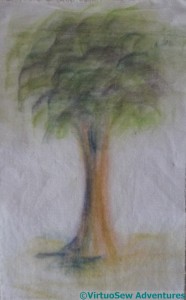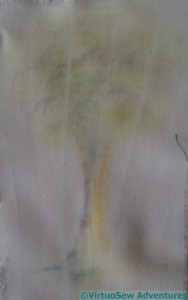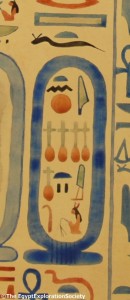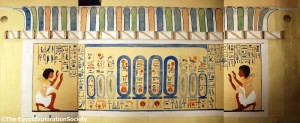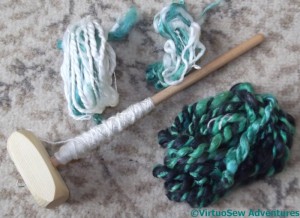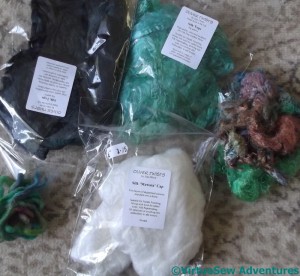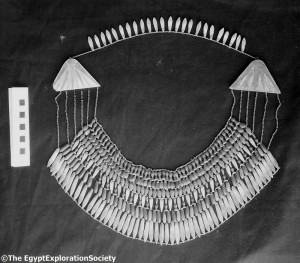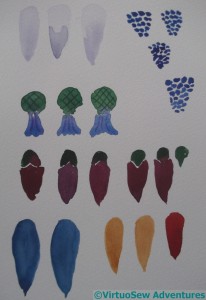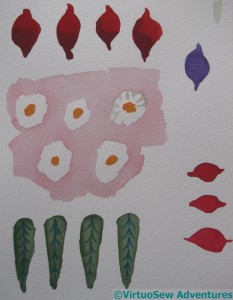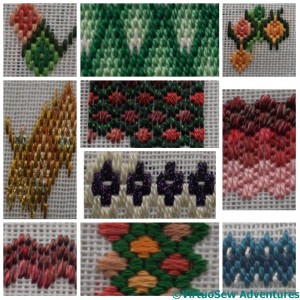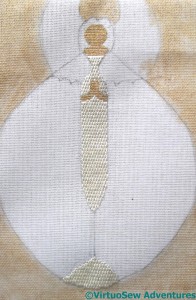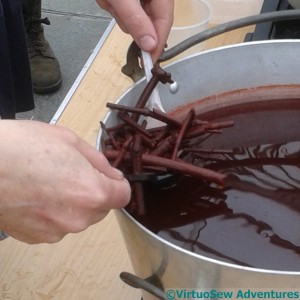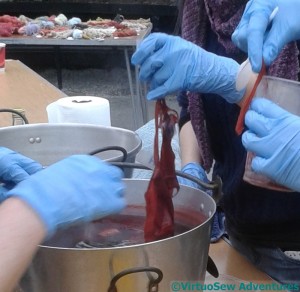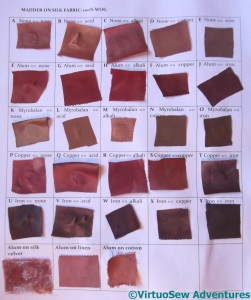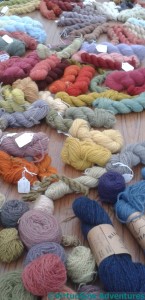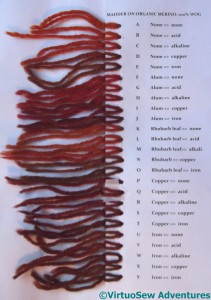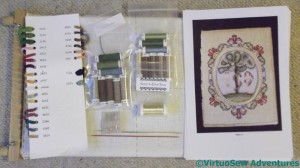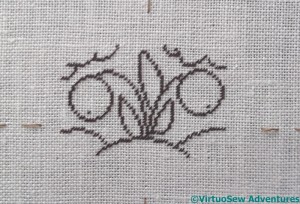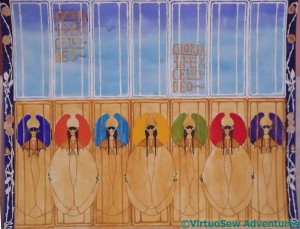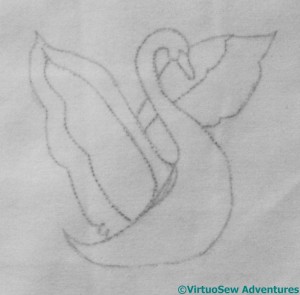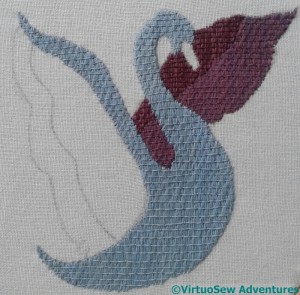About Rachel
View all posts by Rachel
Thinking about The Conversion Of Placidus
I still believe there is a lot to do for the Dreams of Amarna, but at the same time, when I have moments when I know what I am doing and have brain power to spare, I am thinking about the Conversion of Placidus panel that I’d like to do, inspired by Elizabeth Goudge, Pisanello, and La dame a la licorne.
In fact I’ve already bought some calico for the base layer and I’m wondering how to get the design onto it in a reasonably stable but not intrusive fashion. Inktense blocks have been suggested, and when I bought some I was told that once the pigment has been washed over with water, it becomes permanent.
So I found a scrap of cotton and sketched a rather cotton-wool-ball-on-a-stick sort of tree on it, using all of the colours in my selection.
Then I painted over it with water, allowed it to dry, and ironed half of the picture.
Then the scrap went into the washing machine. I’m not expecting to do this to Placidus, by the way. It’s just that I assumed that the abrasion would be a good challenge even if the detergent wasn’t, and it will certainly be subject to abrasion when I’m making it!
As you can see, the ironing made no difference at all!
A lot of the colour has gone, but I think this is in fact enough for my purposes. Most of the panel will be applied to the calico, one way or another, so however I get the design onto the calico, it will only be a sketch map to keep me on the right track.
I do know about textile medium, by the way, but my supplier of the Inktense didn’t have any!
The Cartouche of Nefertiti
Akhenaten and his Great Royal Wife Nefertiti are prominent characters in Mary Chubb’s imaginative response to the city they built, so I feel they need to appear more than once in the embroidery as well. The trick is to balance the story of the archaeology and the archaeologists with the story of the ancient inhabitants..
The gauze overlays I plan will give the sense of the Pharoah and his Great Royal Wife brooding over their city, but among other things I want to include their cartouches.
A few weeks ago, I attended an evening lecture about woven patterns discovered by Howard Carter in Tutankhamun’s tomb (more on that another time!) at the Egypt Exploration Society, and spoke briefly with the Director, Chris Naunton, who has been very helpful to my research in the past. I mentioned that I would like to do at least one set of cartouches in colour. There was a thoughtful pause, then he said “I think I have the very thing – send me an email to make sure I don’t forget, but it is just a matter of finding the file!”
I hadn’t even arrived home the next day when an email showed up in my inbox. The image showed a composite of watercolours by Hilda Pendlebury, depicting Hatiay’s Lintel. This was a carved and painted door-lintel discovered in the very season Mary was writing about, and what’s more, mentioned at some length in the book. It was both archaeologically and historically interesting (two of the cartouches were scratched out in antiquity), as well as providing a challenge to transport, being large, heavy, and because of the embellishment rather fragile.
My current thought is that I will work a version of the cartouche of Nefertiti, either in cottons or silks, either directly on the pale faience coloured linen or maybe on the fabric I used for the Faience Hippopotamus, which would help to balance him slightly. I’ve been reassured that I won’t give any Egyptologists apoplexy if I tweak the colours slightly….!
Spinning
I don’t usually go to workshops at the Knitting and Stitching Show, but since I’ve taken to going to the Thursday evening opening as well, I thought I would have time this year.
And I did. I went to a workshop on Spinning Silk Mawata with Ruth MacGregor, and came back with my very own drop spindle to play with.
First of all I’ve never been to any fibre related workshop at which there were tubes of handcream on the table! Secondly, although I have – literally! – written a book about spinning, I’ve never held a drop spindle in my life and I had no idea what to expect. My book is about industrial spinning, and the machines always did the difficult stuff…
It turns out that silk mawata is a web of filament that can be drafted (stretched) and spun fairly easily – it’s a forgiving material, and because silk is so strong and the filaments are so long, it’s easy to draft and create fine threads. Of course, that means that spinning heavier threads is going to take a bit more thought and care.
Or – since Ruth taught us how – there is always the possibility of twisting two threads together to make one. In the photo above you can see my early efforts. The two light ones are both fairly simple plied yarns, but speaking as a fancy yarn specialist, the dark one is a slubbed gimp yarn. I just wish I could claim that that was exactly as I designed it to be!
So I came home with a packet of silk mawata caps and some silk tops, so I can play and learn to make the thread I want to make.
Eventually I want to be able to spin in both wool and silk, and use some of my yarns in the Vision of Placidus panel…
The Faience Necklace
After Mary Chubb had her moment of epiphany with the tile fragment I reinvented for The Fragment of Tile That Started It All in that Bloomsbury basement, she returned to the office, and her first task was to re-type a recently-arrived Director’s report, since it arrived in no state for publication (“Typed on camelback in a sandstorm“, as she described it).
The first item described in that (shockingly mis-typed) report is a necklace of faience, made using rows and rows of faience shapes in different colours, shaped to depict fruits, leaves, and flowers.
Naturally, I want to embroider a piece that will recall that necklace. Equally, as you can see in the photograph, if I were to attempt to embroider the whole thing, it would either have to be huge, or it will risk being tiny, cramped, and not doing justice to the enchantment she describes.
So I have decided that I am going to create a design that shows only a segment of the necklace. So far that has been hard to do.
I have tried several draftings and redraftings, and these watercolour fragments are the beginnings of the fourth (or is it the fifth?) attempt to devise something reasonable. I am trying to learn the shapes of the various elements – lotus petals, bunches of grapes, cornflowers, dates, palm leaves.
What happens next is for another time. I may well be back once more to primary school, cutting out and sticking down pieces of paper.
I’m so keen to use all my shiniest threads to depict the faience that I’m becoming very short-tempered with myself…!
A Christmas Angel
While I am still trying to work out how to do the Chorus of Angels, I’ve decided to work a single Angel from the Chorus in an entirely different medium – needlepoint. The original idea was to have it done by Christmas, but I’m becoming aware that that isn’t very likely now.
Once I’d made that decision I had a lot of fun playing with bargello patterns and trying to choose something suitable. I’m using a fine canvas – 18 count, I think, although as it came, unlabeled, in among that collection of supplies that included several frames, I’m not sure. It’s full of size and is going to be rather a trial to stitch, I fear.
I’ve decided to use the gold pattern on the far left (slightly altered) for the background, to give an effect a little like the patterned gold background of an icon. The lines of this panel are so simple that I can afford to use some quite complicated patterns, I think.
In the end I settled on the green and red spots in the upper middle for the cape, although choosing the colours hasn’t been quite straightforward. The wings are still puzzling me.
Since I have decided on a gold background for the angel, I decided to paint the background canvas gold as well. That will help to boost any thin coverage.
I’ve worked the gown underneath the cape very simply, in cream brick stitch, and the face and hands using gold tent stitch. None of the variants of flesh colour seemed right, and the gold does at least belong in the design.
The opening salvo
I did study the techniques of dyeing and printing during my degree course, but that was industrial printing and dyeing, on a vast scale and using chemical dyes. Using natural dyes and working on a smaller scale will be a whole new adventure. It isn’t as consistent, but then that is the charm of it.
So off I went, rummaging through the interwebs for an introduction to natural dyeing and finally found it via Twitter, in a workshop entitled “Twenty Five Shades Of Madder” in the Glasgow Botanic Gardens given by Julia Billings of Woollenflower. It was fascinating, and gave me much to think about.
Mind you, I might have given Julia and all the other lovely ladies on the course something to think about as well, because I had my quotation from Pliny in my notebook to explain what an embroiderer was doing at a workshop, run by a knitter and attended largely by knitters.
It did more than explain – everyone’s imagination went into overdrive! The idea of multicoloured fabric coming out of a single dyebath clearly enchants everyone, not just me!
We even had a walk through the Gardens looking for plants that yield dyes. There are a lot of them – more than you might think!, and mordants (pre-dyebath treatments) and modifiers (post-dyebath treatments) make a lot of difference as well.
So now, I have a list of books and DVDs to look at, and suggestions of other people to get in contact with or research – and someone to ask for help if it all gets too much (thanks, Jules!)
Eve In The Garden of Eden Bookcover
There’s another Thistle Threads course starting, a book cover called “Eve In The Garden Of Eden“, and I was highly intrigued by it.
I was even more intrigued by two of the items that came with the first kit. They look rather like double ended knitting needles, but the picture doesn’t seem to included anything knitted. The kit also includes an assortment of gimps, a gold thread, and a wonderful selection of silk floss. I’ve fallen in love with silk thread since I started following Tricia’s courses, and while I still find uses for my cotton, linen, and wool, silk is always a treat.
The first stage is all in tent stitch. The fabric is 30 count, which is fine enough to that I have been using both my goosenecked magnifier, and my magnifying glasses. This is the central panel of the spine. I’ve decided to enlarge the chart before I do any of the colour stitches, because the chart is a bit small, but I’m rather pleased with it so far.
I’m going to try to keep up with this course, because I’ve just seen that there is a Stumpwork Lion course being planned, and he looks wonderful!
Chorus of Angels
My mother and I have been planning a backdrop for some crib figures I inherited some years ago from a great aunt.
We started off by thinking about a stylised landscape (I might still do that one of these days), and then we thought about some sort of embroidered “stable” (likewise!), but none of the ideas really came together.
The crib figures are simple, and carved in wood, and we think they were bought in Germany after the war. We think that simplicity might be best set off by something really gorgeous and colourful, so then my mother designed a chorus of angels inspired by the “May Queen” design by Margaret Macdonald Mackintosh. She substantially simplified the basic design, added wings and then created two ranks of singing angels.
She’s also created a wonderful top panel of graduated blues and superimposed the text “Gloria in excelsis Deo” over the top. At the moment we are thinking about creating an ombré dyed section for the graduated panel, and couching gold and silver threads to make the framework. Then maybe using golden gauze for the lower panel, using a second layer for the capes.
As for the wings – well, detached buttonhole stitch, perhaps? Maybe in Gilt Sylke Twist, if I can get the right colours. I’m torn between a rainbow of colours, as my mother has painted them, or some other selection. Really, it will depend on what takes my eye when I get to that stage!
We want to work it on silk, and I want to be a bit clearer about what I’m doing before I get started. So it won’t be done in time for this Christmas.
Still More Laid and Couched Work – The Swan
The Swan is a much simplified rendition of a photographed one. I decided in the end to change the lines on the nearer wing, so it more clearly grows from the body of the bird, but one of the great advantages of laid and couched work is that it covers such infelicities of drafting – just so long as you remember to ignore the lines that you had decided to ignore (if you follow me…)!
It still looks a little too naturalistic, but the colours will help (blues and purples, like the Unicorn). I will have to work out suitable embellishments for the wings in due course, as well, and that will also help. As it happens, the layer of laid and couched work gave me quite enough trouble!
I wanted to work the body in the pale blue, to maintain at least some link with the real thing (after all, shadows on white often look blue…).
That made it possible to make sure that I reminded myself to include the forward edge of the nearest wing in with the body.
Then the more distant wing clearly had to be in purples as being more distant and helping to throw the body forward visually. And then I came to a grinding halt – which may explain why you haven’t seen the wretched thing.
I enjoy the technique enormously, but it’s taken me all summer to ignore it and clear my head of colour schemes I hated, come back to it, and try again.
Planning Adventures in Dyeing…
When I was working on my Master’s Degree, I came across this reference to dyeing in Egypt, as described by Pliny the Elder in his “Natural History”:
In Egypt, too, they employ a very remarkable process for the colouring of tissues. After pressing the material, which is white at first, they saturate it, not with colours, but with mordants that are calculated to absorb colour. This done, the tissues, still unchanged in appearance, are plunged into a cauldron of boiling dye, and are removed the next moment fully coloured.
It is a singular fact, too, that although the dye in the pan is of one uniform colour, the material when taken out of it is of various colours, according to the nature of the mordants that have been respectively applied to it: these colours, too, will never wash out.
Thus the dye-pan, which under ordinary circumstances, no doubt, would have made but one colour of several, if coloured tissues had been put into it, is here made to yield several colours from a single dye. At the same moment that it dyes the tissues, it boils in the colour; and it is the fact, that material which has been thus submitted to the action of fire becomes stouter and more serviceable for wear, than it would have been if it had not been subjected to the process.
Now, Pliny the Elder was writing long after Akhenaten’s time, indeed after Egypt became part of the Roman Empire, but plant dyes were already known in 18th Dynasty Egypt, so I am going to assume that mordanting was also known.
I simply have to try this!
I’m not going to try to use Egyptian plant dyes – I think it will be quite challenging enough as it is – but I need to do some research to discover what colours can be obtained by different mordants from a single dyestuff, then work out how to apply the mordant in patterns in such a way as to ensure that it works.
And then do it. It would make a fabulous video, wouldn’t it, dipping a white cloth into a vat and getting multicoloured cloth out again!

